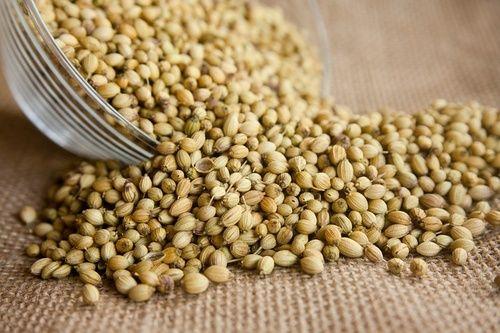The plant from which the Coriander it belongs to the Ombrelliferae family and is native to the Mediterranean countries.
Share coriander are use both the leaves, more spicy and appreciated especially in the East (for this reason it is also known as Chinese parsley), than the fruits, peppercorns similar to peppercorns, yellow and with a sweetish flavor reminiscent of lemons.
> Properties and benefits of coriander
> Calories and nutritional values of coriander

Properties of coriander
Coriander is carminative, antispasmodic e stomachico, it is therefore a good natural remedy against abdominal colic, digestive difficulties e swelling.
With coriander you can prepare a digestive infusion, effective and with an aromatic flavor: just put 2 grams of coriander seeds in 100ml of boiling water for a few minutes. A couple of tablespoons after meals will be enough to promote digestion and the elimination of intestinal gas.
His stimulating effect reduces the sense of fatigue, fights inappetence and makes it a good tonic for brain activity and the nervous system.
Coriander also has an effect fungicidal and antibacterial.
Calories and nutritional values of coriander
100 g of fresh coriander contains 23 kcal, e:
- 2,13 g protein
- G carbohydrates 3,67
- Sugars 0,87 g
- 0,52 g fat
- Cholesterol 0mg
- Dietary fiber 2,8 g
- Sodium 46 mg
Coriander among the natural remedies for difficult digestion

Use in the kitchen
Coriander, with his delicate aroma, it can be added in many gastronomic preparations without covering the taste of the dishes.
This spice lends itself very well to flavor soups e soups, legumes, meat, fish and vegetables, especially cabbage and sauerkraut.
Whole seeds are indicated in the preparation of pickles and brines while ground they are perfect for flavor meat, fish and sausages.
Coriander is an excellent ingredient for spice blends due to its delicate flavor and we find it among the ingredients of curry and garam masala, the Indian spice blend.
of combinations with other spices to try are the one with thyme and pepper to give an exotic touch to the boiled rice and the one with nutmeg to flavor the mashed potatoes.
In international cuisine coriander is much appreciated, less so in el paesena, where it is used in the preparation of sausages (often mistaken for pepper) and as a flavoring for liqueurs and digestives.
In Morocco it is used in marinades and meat fillings while in Egypt it is paired with beans.
In Nibujon the leaves are more used, whose smell is very strong and not pleasant to everyone, to flavor salads and soups.
Coriander leaves are also present in many Mexican food.
In 'central Europe coriander seeds flavor game, pickles and brines, vegetables and mushrooms.
in Balkans it is a very popular spice to flavor bread, fruit and some sweets.
Coriander is used in the preparation of liqueurs and digestives, we find it for example in Ratafià, in Gin and in the Chartreuse.
Curiosities about coriander
Coriander was well known in antiquity and Pliny the Elder suggested putting some coriander seeds under the pillow to prevent fever and headache.
When sowing cilantro it is good to know that it can affect the growth of neighboring plants: for example, fennel suffers if grown next to coriander while anise draws strength from it.
The word coriander derives from the Latin term Coriandrum which in turn has its roots in the Greek word corys (bedbug), followed by the suffix -ander (resembling). The name of this plant refers to the unpleasant smell which emanates until the period of fruit ripening, similar to that of bedbugs. For this reason the coriander plant is also known as weed bug.
Another curiosity related to the name of this spice is the reason why today we call confetti the pieces of colored paper that traditionally are thrown at Carnival: in the fifteenth century, during the celebrations, sugared almonds were thrown which often consisted of glazed coriander seeds. Over time these sugar sweets have transformed to become the paper discs we know today and which have kept the name of the spice they replaced.
READ MORE
Coriander is an aphrodisiac spice. Discover the others
More articles on cilantro
> Deflating herbal teas with coriander
> 5 aromatic herbs to be included in the diet
| Pixabay


























